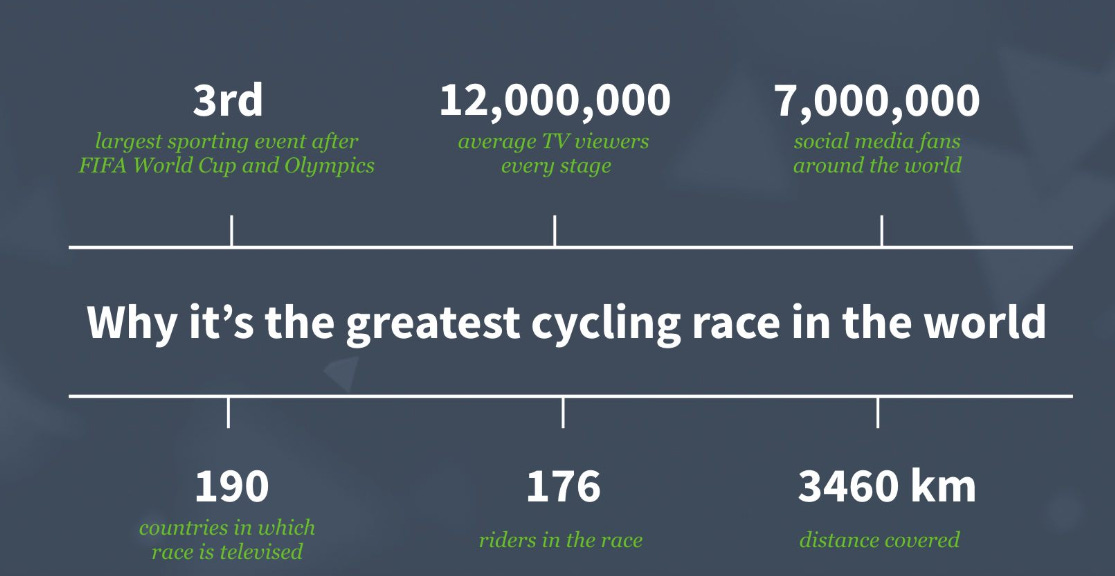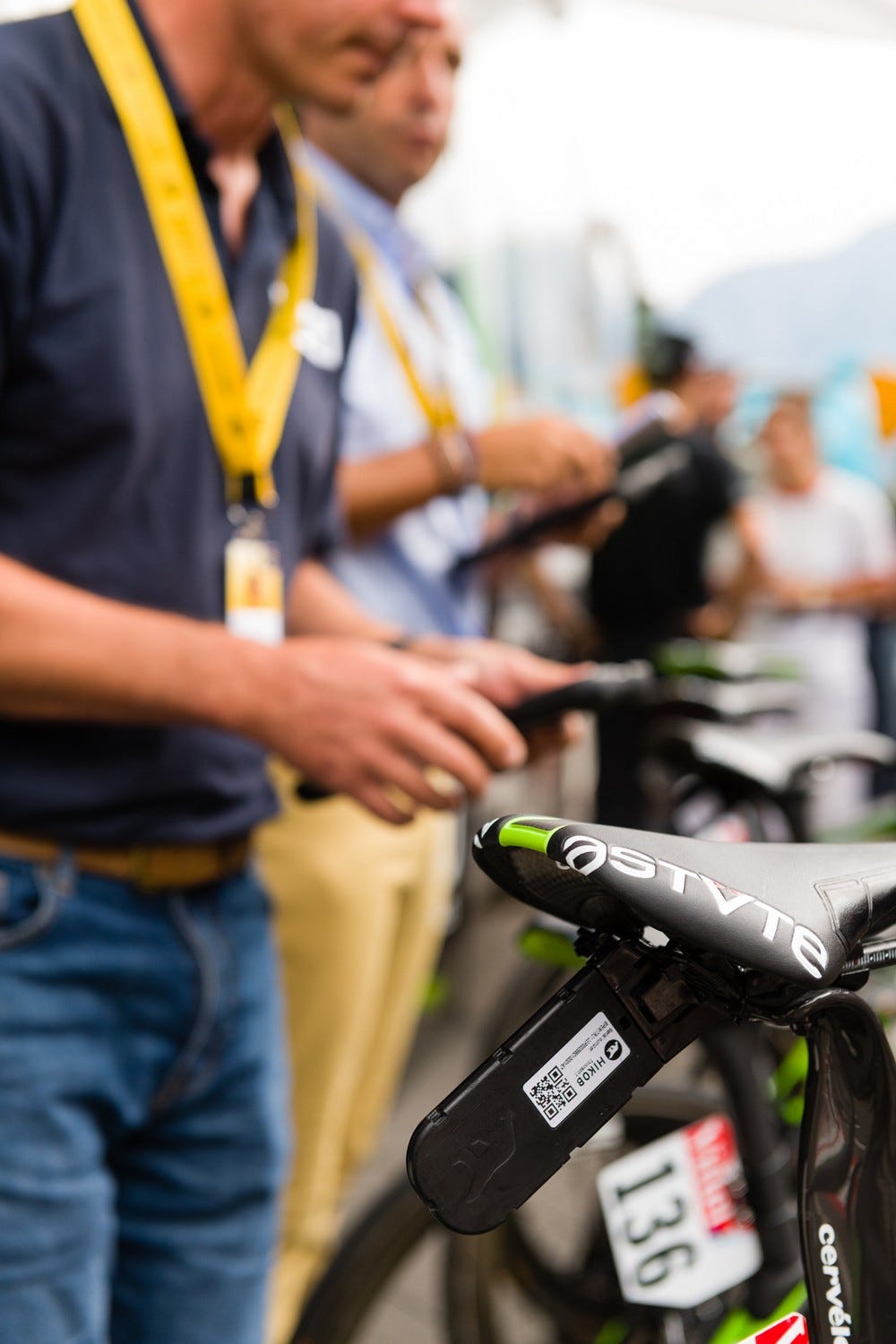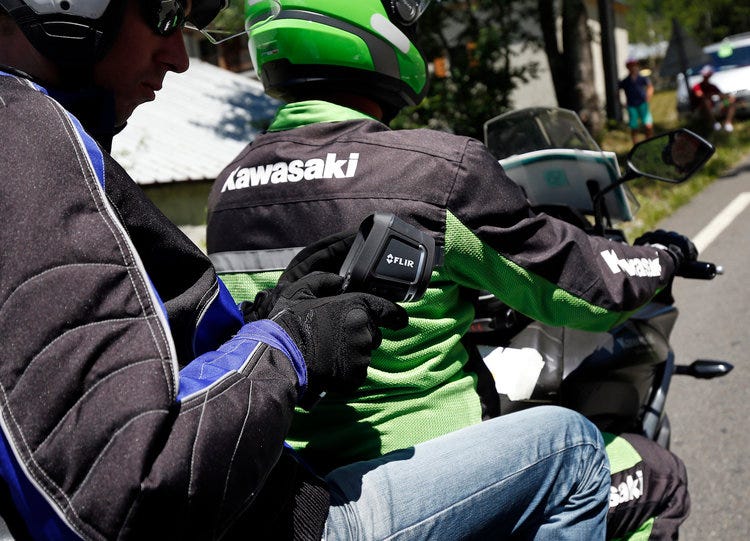From wearables, GPS, augmented videos..to VR/AR
The Tour de France is the biggest cycling race in the world. It is also the 3rd largest sporting event in the world after the FIFA World Cup and the Olympics. In fact, as shown in the picture below, on average 12M TV viewers are watching every stage. The Tour de France is also televised globally across 190 countries. It also has a great social presence with 7M fans on social media.
 Over the years, technology has also become a big part of the viewing experience. Before we discuss specific examples of the tech used at The Tour de France, let’s talk about the cycling tech ecosystem. The key tech sub-segments are as follow:
Over the years, technology has also become a big part of the viewing experience. Before we discuss specific examples of the tech used at The Tour de France, let’s talk about the cycling tech ecosystem. The key tech sub-segments are as follow:
(1) ? Wearables: This segment typically includes wearables from various shapes and forms such as smart patches, smartwatches, fitness bands, smart t-shirts, smart shorts, smart shoes/insoles embedded with sensors capable of measuring athletes’ biometric data (HR, HRV, workload, oxygen level, fatigue, breathing, height, hydration, and more). Key players include companies like Hexoskin, OMsignal, Polar, Adidas, Samsung, Apple, Sony, Fitbit, Garmin, adidas, LG, Humon, Kenzen, Motorola, Kenzen, Gatorade, MC10, iRythm, Vital Connect, among others.
(3) GPS trackers: These are typically vendors who provide GPS trackers that can track the location, distance ran, speed of cyclists. Key players in the space include companies like Wahoo, Garmin, Mio, Lezyne, Cateye, just to name a few.
(3) VR: This category includes VR training systems for cyclists. They an be described as VR experiences enabling cyclists to virtually bike anywhere in the world and train that way. Concretely VR users would use a VR headset and seat on a stationary bike. Key players include companies like CycleVR, VirZoom, NordicTrack, just to name a few.
(4) Augmented video vendors: Dimension data is one of the biggest players in the cycling world. Its technology enhances the live TV experience, who are creating new types of live viewing experience on TV, second screen apps (e.g. AR overlays).
(5) ? AR glasses and contact lenses for cyclists: This category includes the AR/MR glasses vendors who build the smart glasses for cyclists that create a handsfree experience and display AR as an overlay on connected glasses. Leading players in this area include companies like Everysight, Solos, Garmin, just to name a few. Other vendors like Emacula are also building AR contact lenses for cyclists.
So what are the future trends and which emerging technologies should we expect to see in the world of cycling in the coming years?
- From wearable 2.0 to wearable 3.0:
There are currently a myriad of wearables for cyclists that can measure HR, HRV, steps and calories. But we are also seeing the emergence of advanced wearables that can go beyond, measure new biometric data, and are clinically proven. One of those startups is Humon which built a wearable device called the Humon Hex, which measures muscle oxygen use in real time to get a read on exertion. This wearable device essentially tells athletes exactly how hard to push in training sessions and when to takes rests. Humon, a company which was born out of MIT Sloan, has boasted a 40 percent month-over-month growth. And now, a number of world class athletes are leveraging the Hex to seek an edge.
In addition to receiving data on distance and splits via GPS and heart rate, a cyclist wearing the Hex can receive graphical feedback on their smartphone, smartwatch, or bike computer to quickly understand how hard they’re pushing. The Hex guides cyclists through a display of colored training zones—green, blue, orange, and red—which change in real-time based on the athlete’s level of oxygen demand versus consumption. A blue shade indicates they’re in recovery, while orange indicates a person is at their limit, and red warns that the current level is unsustainable. A person might spend most of their time on recovery days in the blue and green, while bursting into the orange and red on interval days. The scale is personalized and changes based on a person’s level of fatigue heading into the workout.
As Humon CEO explained, “your red zone today is going to be different than your red zone tonight or tomorrow.”
Using the device, athletes can perform regular lactate threshold tests and measure the exertion of their muscles to understand when they need to push harder or ease up for recovery.
Humon CEO said lactic acid is a lagging proxy for muscle oxygen, but that oxygen consumption enables real-time feedback. Compared with a heart rate monitor alone, this enables athletes to get a more accurate read on their workouts so they can determine how hard or easy they’re working.
In the future we expect to see more cycling teams to use these types of advanced wearables to improve training, better measure fatigue, and know when a cyclist is about to reach his/her limit. This is critical as it can help prevent major injuries down the road.
- Data visualization, coupled with GPS/wearable, enhancing the cycling viewing experience on TV:
Every year, fans of The Tour de France are able to watch Tour on live TV and see the speed, location of cyclists in real time, and much more. The tech company behind this great viewing experience is Dimension Data.
So how does it work?
Dimension Data is collecting the data from the bikes using GPS trackers, creating a mesh network that connected all of the bikes with the motorcycles as they moved round, sent a signal up to a fixed wing aircraft or a helicopter which was then transmitting back to their data truck. The data is also being shared with the broadcasters to enhance the viewing experience on live TV.
Here is the video that illustrates the experience which enhance the fans experience at The Tour de France.
Video: Dimension Data
Here is a picture of the GPS tracker embedded into the bikes.
Because of all the attention that Dimension Data gets during the race as a tech provider as well as a sponsor of a cycling team, it should not come as a surprise that DimensionData.com generally sees a 50% spike in traffic during the Tour de France,
So what types of future fans experiences is Dimension Data likely to build in the future?
Here is a clue of what Dimension Data could be offering to fans in the future:
“What is that going to look like? Virtual reality gaming where you’re riding against your favorite riders; 3D terrains that you can look at away from broadcast screens – that’s a lot of what we’re starting (..) We would love to put 3D terrains on to people’s coffee tables, and to instantly update the truck. Whether that’s going to be something we can technically do we don’t know”, said Dimension Data’s UK and Ireland managing director Barney Taylor.
- Thermal camera to fight “motor’ doping:
Back in 2016, the International Cycling Union conducted 3,773 tests for technological fraud — aka motor doping— at the Tour De France using magnetic-resistance technology via a tablet app. There were zero positives. It all goes back to February 2016, when a Dutch rider was caught at the cyclocross world championships with a bike that had a motor hidden in the frame.
So how does it work? A thermal camera was used for the first time without warning at the Tour in 2016, in a bid to detect hidden motors in riders’ bikes, AFP reported. The camera was developed by the French Atomic Energy Commission and used alongside magnetic-resonance testing. “No one saw it, no one knew,” Thierry Braillard, the French secretary of state for sports, told AFP.
Bottom line: Technology has become at the core of the cycling experience, whether it is about improving the fans experience (VR, AR, etc.) or sports performance (e.g. wearables, GPS, etc.) of cyclists. Companies like Dimension Data has become one of the key tech enablers in the world of pro cycling. In the long run, we expect more teams to adopt advanced wearables in order to help them improve the performance of cyclists, and prevent major injuries.



Leave A Comment
You must be logged in to post a comment.